Supporters’ club: the gallerists-turned-producers making artists’ wildest dreams come true

For nearly two decades, Galerie Jérôme de Noirmont presented an enviable roster of contemporary artists at its upscale space on Avenue Matignon in Paris: Jeff Koons, Shirin Neshat, Pierre et Gilles, Keith Haring, AR Penck and many more. The art market was booming and things were good. So it came as a surprise when Jérôme and Emmanuelle de Noirmont, the ultra-chic couple behind the gallery, announced its closure in March 2013. ‘Our field has changed profoundly since our opening,’ their statement read. ‘The future seems to lie with small niche galleries or else powerful, important mega-galleries.’ To best serve their artists, they felt their business had to grow, yet they feared the Socialist government’s policies would drive away wealthy French collectors. Instead of expanding, they decided to shut their doors and start something else.
In 2015, after helping all their artists find new galleries, they launched Noirmontartproduction. Embracing the art market’s radical transformation, they envisioned a brand new model: producers of art, similar to producers of films. As everything in the art world grows bigger – museums, galleries, foundations, fairs, artworks, collections, egos – the industry’s appetite is voracious, and many dealers have neither the time nor the means to produce art at such a pace.

Panorama', by Eva Jospin, 2016. Created with Outsign architects, with a cardboard forest inside, this was the first contemporary work shown in the Louvre’s Cour Carrée. Courtesy of Noirmontartproduction.
This is where the de Noirmonts come in, offering made-to-measure production services ranging from financial assistance to technical management. Already they’ve helped to realise installations, sculptures and films for galleries and institutions around the world, from Berlin to Mexico City. As for their business model, they admit they are still figuring it out. At times they wait until a work is sold to recoup their investment and take a cut of the proceeds. Sometimes they receive an artwork as payment. At other times they help finance a project because they believe in it, wanting nothing in return. ‘We can’t expect huge profits,’ Jérôme says. ‘We are no longer dealers.’
Such uncertainty has never bothered the couple. Their gallery signed Jeff Koons in 1996, when many others wouldn’t touch the artist, fearing the kind of cost overruns and production delays that forced the Guggenheim Museum to cancel a retrospective that year. In 2000, the de Noirmonts financed Koons’ Split-Rocker, an immense and complex stainless steel sculpture covered with tens of thousands of flowering plants. ‘We took a big risk, but it seemed essential,’ says Jérôme. The couple came out ahead and laid the groundwork for a friendship that continues today.
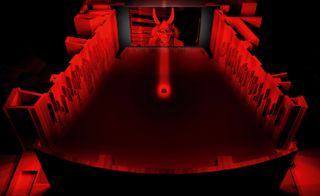
'Sculpt', by Loris Gréaud, 2016. A model of the Bing Theatre at LACMA, where Gréaud’s film was played to one viewer at a time. Courtesy of Loris Gréaud/Gréaudstudio
‘We take utopian projects and bring them to life,’ says Emmanuelle. This often means coming up with the money to pay for a project, and it’s frequently their own. In 2015, Parisian gallerist Frank Elbaz told Jérôme about an installation that one of his artists, avide Balula, wanted to create for the Parcours sector at Art Basel. Half an hour after meeting Balula, de Noirmont agreed to finance the project. Called Painting the Roof of Your Mouth (Ice Cream), it involved roaming cycle carts handing out ice cream to passers-by. The ice cream (by Michelin star-winning chef Daniel Burns) came in flavours that reflected Balula’s oeuvre, such as burnt wood. Originally, Balula imagined an ice-cream parlour and one cart; Jérôme insisted he create two. ‘It was more expensive, but more visible,’ de Noirmont says. ‘This work needed to serve as a trampoline.’
Elbaz says the de Noirmonts have filled a need: ‘They intervene in the beginning, so that a project can exist, and then later on, using their network to give it the best possible visibility.’ The dealer has worked with the couple again to co-produce Sheila Hicks’ textile installation Apprentissages. Part of the 2016 Festival d’Automne à Paris, the work is showing in three parts: at the Musée Carnavalet (where it featured in September), in various shopfronts (currently), and at the Théâtre Nanterre-Amandiers (9 to 17 December).
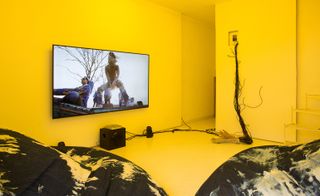
'Dear Chantri, the You of the Future…', by Korakrit Arunanondchai, 2016, an installation/exhibition at Lodos Gallery in Mexico City. Courtesy of the artist and Lodos Gallery, Mexico
Sometimes the de Noirmonts work directly with artists – again, not as dealers but as producers. When conceptual artist Loris Gréaud needed funds for the post-production of Sculpt, his feature-length film, they stepped in, even though the movie would never break any box-office records. Starring Willem Dafoe and Charlotte Rampling, Sculpt played daily this summer at the Los Angeles County Museum of Art, but to only one spectator at a time. Folly? ‘It doesn’t matter,’ says Jérôme. ‘The project had to exist.’
Gréaud says it was reassuring to meet people who believed in investing in something that ‘made sense’, not just profit, and that the de Noirmonts’ approach is extremely rare today. ‘They never asked me to put their name in the credits, never asked where their logo would go, never requested that it be placed at the entrance,’ he says. ‘Just once, they asked me very nicely if they could put my film on their website.’
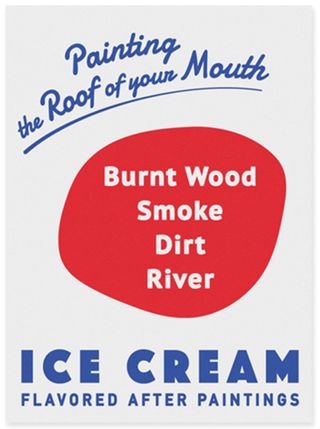
'Painting the Room of Your Mouth (Ice Cream)', by Davide Balula, 2015. At Art Basel, cycle carts gave out ice cream made by chef Daniel Burns in flavours that reflected Balula's work. Courtesy of Galerie Frank Elbaz
Their financing also permitted little-known French artist Eva Jospin to realise Panorama: a grotto-like installation with a mirrored surface on the outside and a 360-degree cardboard forest inside. It was Emmanuelle’s idea to show it in the Cour Carrée of the Louvre, where a contemporary artwork had never been exhibited, and they made admission free so a maximum number of people could attend. Between April and August this year, 300,000 people saw Panorama, which is now set to travel to other cities around the world.
Sometimes the couple act as consultants, applying their experience of the industry’s nuts and bolts. When New Galerie in Paris was preparing to present an aluminium sculpture by New York-based Artie Vierkant for the 2015 FIAC art fair, it assumed the work would be made in the US. But the de Noirmonts had the piece built less expensively in France, which also served to avoid transport fees and import taxes. ‘Art is an economy,’ Jérôme says. ‘Production is important. On average it represents at least a third of the price of a work.’

'Texture Map (Normal) J01 – J04 Smoking or Bus Shelter', by Sean Raspet 2015, shown by New Galerie in Paris’ Jardin des Plantes as part of the FIAC 2015 art fair. Courtesy of New Galerie
The couple’s current undertaking is their most important yet: a ten metre-high sculpture, to be permanently installed in a public space in Paris, and to honour the victims of the November 2015 terror attacks. It will be a gift from the artist, but there are many details to iron out: financing, permission, technical aspects, the artist’s extremely high standards.
Again, the de Noirmonts are working behind the scenes, in the belief that the project must be realised. ‘I will take great satisfaction in bringing my grandchildren to see it, knowing I had something to do with its existence,’ says Jérôme.
As originally featured in the December 2016 issue of Wallpaper* (W*213)
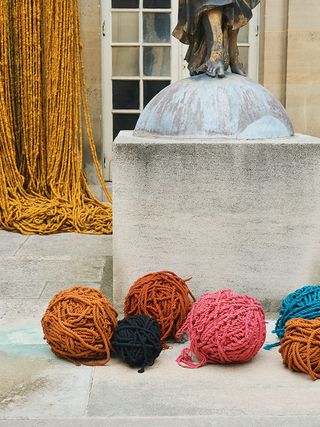
Detail of Apprentissages, by Sheila Hicks, 2016
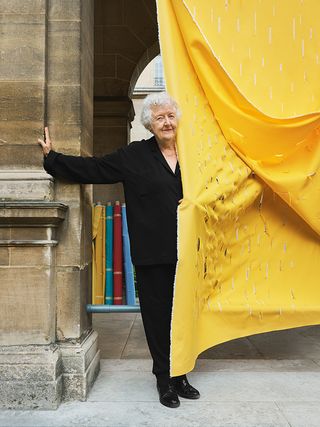
Created by Hicks for the festival d'Automne à Paris, this textile installation was co-produced by the de Noirmonts in collaboration with Galerie Frank Elbaz and fabric manufacturer Sunrella
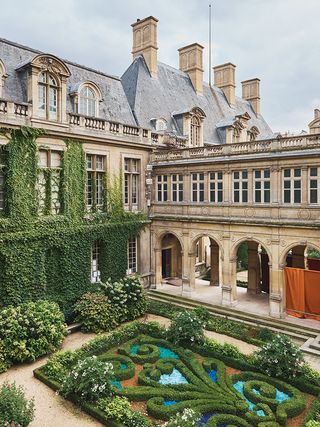
First exhibited at the Musée Carnavalet (pictured), the work is currently showing in various shop windows in Paris, and will feature at the Théâtre Nanterre-Amandiers during December
INFORMATION
For more information, visit the Noirmontartproduction website
Wallpaper* Newsletter
Receive our daily digest of inspiration, escapism and design stories from around the world direct to your inbox
-
 Utilitarian men’s fashion that will elevate your everyday
Utilitarian men’s fashion that will elevate your everydayFrom Prada to Margaret Howell, utilitarian and workwear-inspired men’s fashion gets an upgrade for S/S 2024
By Jack Moss Published
-
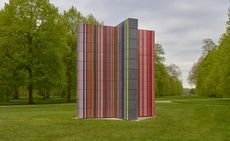 Gerhard Richter unveils new sculpture at Serpentine South
Gerhard Richter unveils new sculpture at Serpentine SouthGerhard Richter revisits themes of pattern and repetition in ‘Strip-Tower’ at London’s Serpentine South
By Hannah Silver Published
-
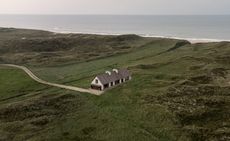 Vipp’s Scandinavian guesthouse offers a sleek setting amid a wild landscape
Vipp’s Scandinavian guesthouse offers a sleek setting amid a wild landscapeVipp Cold Hawaii is a Scandinavian guesthouse designed by architecture studio Hahn Lavsen in Denmark’s Thy National Park
By Sofia de la Cruz Published
-
 The best London art exhibitions to see now
The best London art exhibitions to see nowYour guide to the best London art exhibitions, as chosen by the Wallpaper* arts desk
By Hannah Silver Published
-
 Remote Antarctica research base now houses a striking new art installation
Remote Antarctica research base now houses a striking new art installationIn Antarctica, Kyiv-based architecture studio Balbek Bureau has unveiled ‘Home. Memories’, a poignant art installation at the remote, penguin-inhabited Vernadsky Research Base
By Harriet Lloyd-Smith Published
-
 Ryoji Ikeda and Grönlund-Nisunen saturate Berlin gallery in sound, vision and visceral sensation
Ryoji Ikeda and Grönlund-Nisunen saturate Berlin gallery in sound, vision and visceral sensationAt Esther Schipper gallery Berlin, artists Ryoji Ikeda and Grönlund-Nisunen draw on the elemental forces of sound and light in a meditative and disorienting joint exhibition
By Harriet Lloyd-Smith Published
-
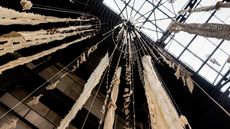 Cecilia Vicuña’s ‘Brain Forest Quipu’ wins Best Art Installation in the 2023 Wallpaper* Design Awards
Cecilia Vicuña’s ‘Brain Forest Quipu’ wins Best Art Installation in the 2023 Wallpaper* Design AwardsBrain Forest Quipu, Cecilia Vicuña's Hyundai Commission at Tate Modern, has been crowned 'Best Art Installation' in the 2023 Wallpaper* Design Awards
By Harriet Lloyd-Smith Published
-
 Michael Heizer’s Nevada ‘City’: the land art masterpiece that took 50 years to conceive
Michael Heizer’s Nevada ‘City’: the land art masterpiece that took 50 years to conceiveMichael Heizer’s City in the Nevada Desert (1972-2022) has been awarded ‘Best eighth wonder’ in the 2023 Wallpaper* design awards. We explore how this staggering example of land art came to be
By Harriet Lloyd-Smith Published
-
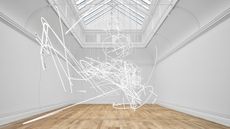 Cerith Wyn Evans: ‘I love nothing more than neon in direct sunlight. It’s heartbreakingly beautiful’
Cerith Wyn Evans: ‘I love nothing more than neon in direct sunlight. It’s heartbreakingly beautiful’Cerith Wyn Evans reflects on his largest show in the UK to date, at Mostyn, Wales – a multisensory, neon-charged fantasia of mind, body and language
By Harriet Lloyd-Smith Published
-
 The best 7 Christmas installations in London for art lovers
The best 7 Christmas installations in London for art loversAs London decks its halls for the festive season, explore our pick of the best Christmas installations for the art-, design- and fashion-minded
By Harriet Lloyd-Smith Published
-
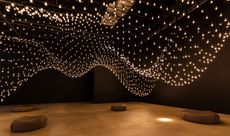 Rafael Lozano-Hemmer’s Pulse Topology in Miami is powered by heartbeats
Rafael Lozano-Hemmer’s Pulse Topology in Miami is powered by heartbeatsRafael Lozano-Hemmer brings heart and human connection to Miami Art Week 2022 with Pulse Topology, an interactive light installation at Superblue Miami in collaboration with BMW i
By Fiona Mahon Last updated